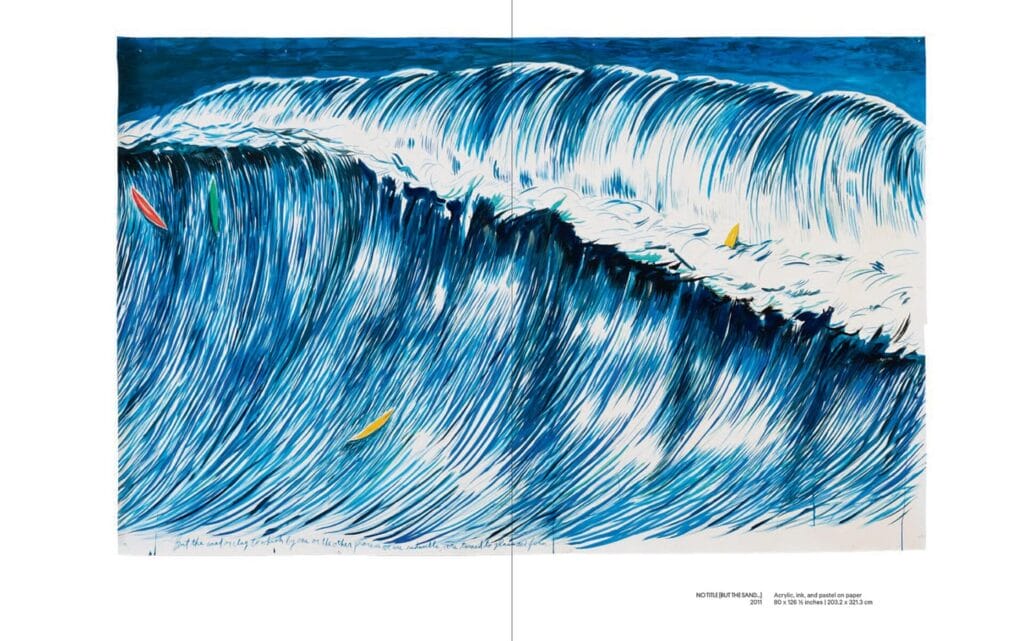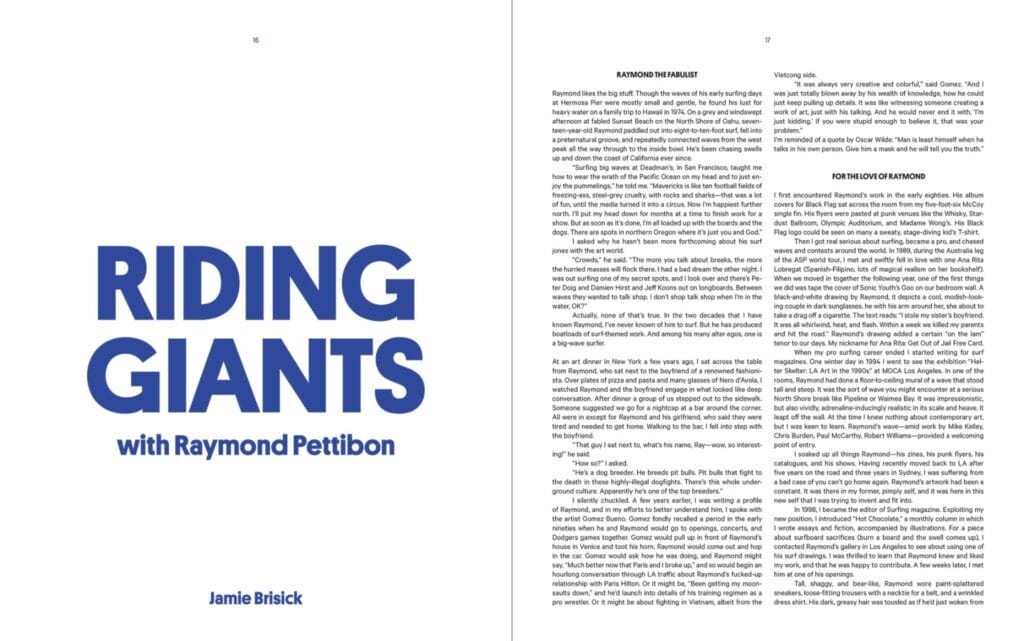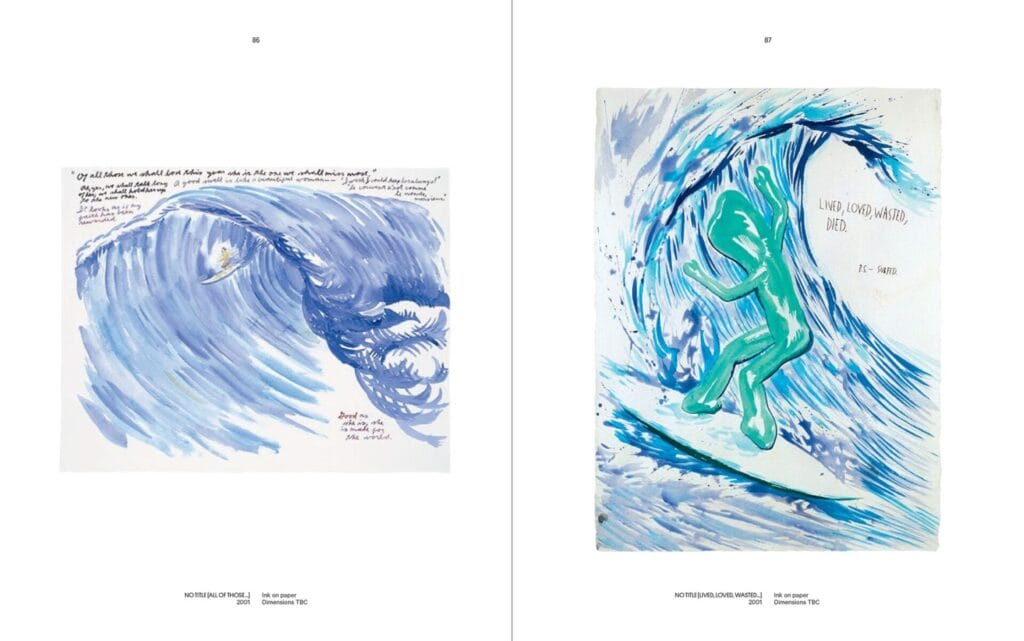“All this must be either surfed or painted”: This is the underlying sentiment behind Raymond Pettibon’s iconic works of surfers and waves in this quintessential volume dedicated to the motif.
Pettibon is known for his characteristically enigmatic aesthetic and sharply satirical critiques of American culture. Though drenched in cynicism, his work empathizes with the dizzying madness of our own humanity as it engages both so-called high and low culture. Perhaps most poetic among the many motifs present in Pettibon’s oeuvre is the surfer. In 1985, Pettibon began Surfers––a series he continues to work on to this day––popular for its depiction of the lone surfer silently carving “a line of beauty” along an impossibly large wave.

“In recent years, Raymond has produced a flurry of surf paintings, most of them pitting a tiny surfer against a giant, spectacular wave,” writes Jamie Brisick. “It’s impossible not to see the self-portrait: Raymond the artist, streaking across the pitching, heaving, throaty blue wall that is his hopes/dreams/ideas that ping around in his head. It’s also impossible not to see how he’s selected the perfect metaphor.”

This publication traces a selection of more than one hundred surfers from the series, from smaller monochromatic works on paper to colorful large-scale paintings applied directly to the wall. For Pettibon’s protagonist in these works, surfing exists apart from all else. Momentarily he achieves sublimity on the wave, distant yet synced with turbulent reality. We are forced to confront our own scale: small and feeble in the face of the power of nature, what is beyond our control. Pettibon’s lyrical writings on these painted surfaces—both his own and lines taken from literature—reference his own philosophies and the confusions of reality: he critiques and highlights the hypocrisies and vanities of the world he engages. To help navigate, the scholar Brian Lukacher explores art-historical antecedents in Pettibon’s work, particularly the seascapes of J. M. W. Turner, and Jamie Brisick, the writer and former professional surfer, examines the Southern California surf and music culture of Pettibon’s youth. The professional surfers Stephanie Gilmore and Emily Erickson also describe the sensory experience of conquering the enormous waves depicted in Pettibon’s works.

As Erickson notes, “People who ride big waves ride them because they want to. That kind of exertion and mental focus is something people want. What you go through mentally and physically and in between swells when surfing big waves, you end up learning a lot that you can translate to life on land.”
ABOUT THE TITLE
June 7, 2022
Hardcover
9 × 12 in | 22.9 × 30.5 cm
204 Pages
IBSN: 9781644230350
$60 | $80 CAN | £45
Raymond Pettibon
Raymond Pettibon (b. 1957, Tucson) is known for his work that embraces a wide spectrum of American high and low culture, from the deviations of marginal youth to art history, literature, sports, religion, politics, and sexuality. Taking their points of departure in the Southern California punk-rock culture of the late 1970s and 1980s and the do-it-yourself aesthetic of album covers, comics, concert flyers, and fanzines that characterized the movement, his drawings have come to occupy their own genre of potent and dynamic artistic commentary, ranging from punchy and political to high literary and extremely poetic.
Jamie Brisick
Jamie Brisick’s books include Becoming Westerly: Surf Champion Peter Drouyn’s Transformation into Westerly Windina (2015), The Eighties at Echo Beach (2011), Have Board, Will Travel: The Definitive History of Surf, Skate, and Snow (2004), and We Approach Our Martinis with Such High Expectations (2002). His writings and photographs have appeared in The Surfer’s Journal, The New Yorker, The New York Times, and The Guardian. In 2008, he was awarded a Fulbright Fellowship. He lives in Los Angeles.
Brian Lukacher
Brian Lukacher is a professor of art history at Vassar College. He is a scholar of late eighteenth- and nineteenth-century British art, architecture, and photography. His publications include the monograph Joseph Gandy: Architectural Visionary in Late Georgian England (2006), and he is a contributing author to 19th-Century Art: A Critical History (2019). His current projects include a volume on J. M. W. Turner and Romantic-period theories of vision and hallucination, and a study on animal perception in Pre-Raphaelite art and the writings of John Ruskin.









